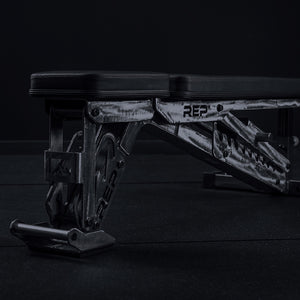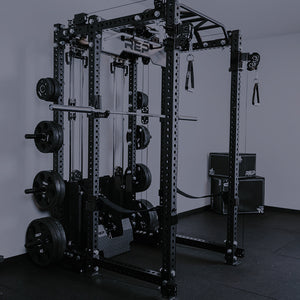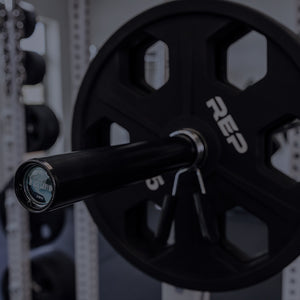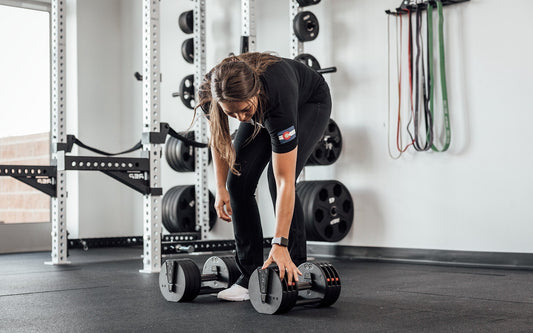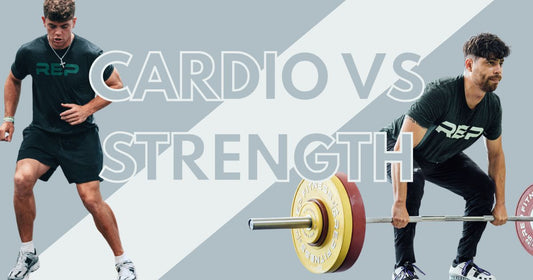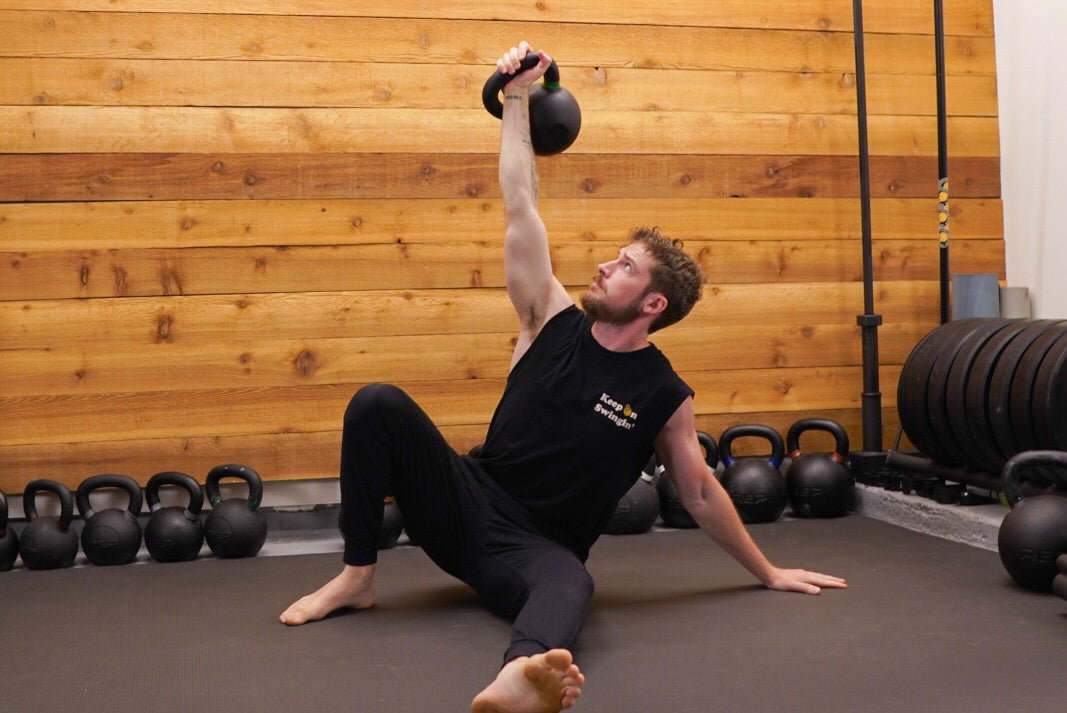
Kettlebell core — for your core.
Kettlebells are versatile tools that can help you strengthen your midsection, burn calories, and boost performance. Try these certified personal trainer-approved kettlebell moves to fire up your abs and obliques while building a stronger, more resilient core.
How do kettlebells train the core?
Kettlebells are handy-dandy free weights — like a bowling ball with a cute little handle. You can lift them, squat them, even swing them around when there’s a home intruder. (I’ve got a kettlebell, and I’m not afraid to use it!)
“Although most people associate the core with abs, its primary function isn’t flexion — it’s stabilizing the spine and transferring force between the upper and lower body,” says Jonathan Flicker, NASM-CPT, CES, and owner of FLICKER STRONG. “Kettlebells are especially effective for core training because their offset center of gravity forces your body to stabilize constantly during movement.”
Jeremy Bryan, REP athlete and founder of the Happy Kettlebelling Club, agrees. "Kettlebells are always trying to pull you out of alignment, so it's naturally going to test your stability."
As such, we’ve put together a list of the 13 best kettlebell core workouts you can incorporate into your routine. And not to sound like your mother, but remember, you always want to warm up before diving into your workout.
The 13 best kettlebell core exercises
1. Kettlebell Frankenstein Sit-Up
How It Works: Take your sit-ups to the next level by introducing resistance — um, hello, we love some progressive overload — and instability. Your core stabilizes your spine while controlling upward motion through your sit-up, then in that pressed position your core muscles engage to keep you steady and stable (physically, not emotionally).
How to Do It: Start out with your back on the ground, knees bent, and kettlebell just below your chest. Grip the handle with the bell racked on the back of your hand and forearm. Extend your arm straight up over your chest before curling up into your sit-up. At the top, your arm should be over your head. To come back to lying down, control your movements back to start.
2. Kettlebell Swings
How it Works: Here you’re training your core to stabilize and transfer power. “In a kettlebell swing, your core braces to keep the spine neutral and resist excessive rotation as you drive the bell forward,” says Flicker. “At the top of the swing, the abdominals (along with deeper core muscles) engage to stop the forward momentum and maintain control.” Think: core bracing and anti-extension.
How to Do It: The kettlebell starts on the floor in front of you. With a flat back, hinge at the hips and hike the kettlebell back between your legs (without letting go and launching it through your wall). As the kettlebell swings forward, drive your hips explosively to send it swinging up to chest height with arms extended. You won’t use your arms to lift the kettlebell, it should lift up and float in front of you from the momentum of your hip drive.
3. Plank Drag

How it Works: Core stability is the focus here. Your abdominals and obliques work to stay balanced while shifting your weight from one arm to the next, dragging a kettlebell beneath you. Your shoulders, triceps, and back will also participate in pulling the kettlebell across while keeping you lifted off the floor.
How to Do It: In a high-plank position, start with your wrists beneath shoulders and feet wide. Reach beneath your chest to grab hold of the kettlebell and drag it across to the other side of your body. You’ll want to keep your hips parallel to the floor, fighting against the urge to rotate. Now, reach underneath you with your other hand and drag the kettlebell back to start.
4. Half-Kneeling Kettlebell Chop
How it Works: This move forces your core to resist rotation as you transfer the weight across your body, targeting your obliques, transverse abdominis, and rectus abdominis.
How to Do It: With one knee down and the other foot planted out in front, as if you’re tying your shoe, hold the kettlebell by the horns. Lift it up and across your body so it’s above the shoulder on the same side as your front leg. Then, chop the weight down and across your torso toward the hip on the opposite side, keeping your torso tall and core braced.
5. Kettlebell Renegade Row

How It Works: The Kettlebell Renegade Row — which sounds like a street some peasants would live on in medieval times — targets your core, back, and biceps, with a little bit of heat for your lower body. Now, when you hold that high-plank position, your deep core muscles engage to keep your spine stable. “Bringing the row in adds the challenge of resisting rotation, making it a powerful anti-rotation and anti-extension exercise,” says Flicker. “As you row one side, the obliques and transverse abdominis fire to prevent your hips from twisting or sagging.”
How to Do It: Set up two kettlebells about shoulder-width apart. Place your hands on the handles and push up into a high-plank position. To keep your hips from dipping or rotating as you row, engage your core and squeeze your buns, booty, glutes — whatever you call them colloquially. Now, try to keep your body from moving as you row one kettlebell up toward your ribcage and return it to the ground with control. Repeat on the other side.
6. Kettlebell Clean
How It Works: This ballistic exercise requires your core to control momentum and keep your spine aligned as you explosively swing the kettlebell up. Since the weight is on one side, your obliques also kick in to keep your body from leaning or twisting.
How to Do It: Similar to a kettlebell swing, start with the kettlebell on the floor between your feet and hinge at your hips. Grab onto the handle with one hand, hike it back, then use your hip drive to bring the kettlebell up into a racked position. Guide the kettlebell to rest on the outside of your arm, keeping your wrist straight and elbow tucked. Reverse the movement to come back to start. If you're feeling zesty, add a press at the top says Bryan.
7. Standing Oblique Crunches
How it Works: The obliques take center stage here in this kettlebell core exercise. As you lower down to the side, they maintain control, then when you return to standing tall, they fire to bring you back up.
How to Do It: With a kettlebell in one hand, tip to the side— bending sideways at the waist to lower the weight towards the outside of your knee. If you’re in a crowded gym, it helps to say, “I’m a little tea pot, short and stout.” Then, reverse that movement to return your torso back to an upright position.
8. Kettlebell Windmill
How it Works: "This is such an approachable movement for people, but it doesn't come off as approachable because it's it's tough," says Bryan. Your obliques are in the driver’s seat with this one, maintaining control through the side bend, while your deep core muscles engage to keep you from toppling over. You'll also get a deep hamstring stretch during this movement, so take it slow if flexibility isn't your strongsuit.
How to Do It: Stand tall with a shoulder-width stance and a kettlebell in one hand, pressed overhead. Angle your feet slightly away from the arm holding the kettlebell. Now, keeping your eyes on the kettlebell — kind of like you would a toddler with ice cream on a white couch — hinge at the hips as your free hand slides down the outside of your opposite leg, maintaining the kettlebell stacked over your shoulder. Go as far as your mobility allows, then engage your tuchus and core to bring you back to standing.
9. Kettlebell Turkish Get-Up or Quarter Get-Up
How it Works: “The Turkish get-up is like several core exercises in one,” says Flicker. “As you move from lying down to standing, your core must resist rotation, maintain spinal alignment, and stabilize against a shifting load.” Basically, it’s anti-rotation, anti-flexion, and anti-lateral flexion all wrapped up in one move. As such, the abs, obliques, and deep stabilizers are engaged throughout to help maintain your balance.
How to Do It: Start lying on the floor with a kettlebell pressed straight up over your chest, same-side knee bent, and opposite arm and leg extended. From there, prop yourself up onto your elbow, then your hand — keeping that kettlebell pressed overhead the whole time. Bryan likes to stop here, at what's considered the quarter-get-up position, which places extra emphasis on the core. If you want to finish the movement, lift your hips, sweep your extended leg under so that you’re in a kneeling position, and stand up. Work those steps in reverse to bring you back down onto your back and switch sides.
10. Kettlebell Halo
How it Works: You are the sun, and the kettlebell, the Earth. Shakespeare said that, right? As the weight moves around your head — slow and controlled, this isn’t a race you hooligan — your obliques and transverse abdominis kick in to keep your torso tall and stable.
How to Do It: Clean the kettlebell up to your chest with the handle facing down. Now, circle the kettlebell from shoulder to shoulder, slowly moving it behind your head. Keep your core engaged, and the kettlebell close to your head, to keep your body from twisting or leaning.
11. Kettlebell Snatch
How it Works: This explosive move brings your core into the equation through stabilization. “As you drive the bell overhead, your obliques, transverse abdominis, and spinal stabilizers work overtime to keep your torso stable,” says Flicker. “Because the load is moving so fast, through a long range of motion, your core has to stay engaged from start to finish.”
How to Do It: Just like the kettlebell clean and swing, start with the kettlebell on the floor between your feet and hinge at your hips. Grab onto the handle with one hand and drive the weight up using your hips, pulling the kettlebell close to your body before punching the weight straight up above your shoulder, fully extending your hips. Then, reverse the movement to return to start.
12. Kettlebell Farmer’s Carry
How it Works: “Unlike dumbbells, kettlebells have an offset center of gravity, which adds a layer of instability and greater demand from your core when it comes to the farmer’s carry,” says Flicker. “As you walk with them at your sides, your obliques, transverse abdominis, and spinal erectors engage to resist side-to-side swaying, forward leaning, and spinal compression.”
How to Do It: Pick up a kettlebell in each hand and walk — boom, done. Easy, right? Just make sure you’re standing tall, shoulders pulled back, and bracing your abs like someone’s about to punch you (also known as engaging your core).
13. Kettlebell Russian Twist

How it Works: Rotational strength and stability is the name of the game. As you twist from side to side, your internal and external obliques engage to control the rotation. Your rectus abdominis works to keep your upper body upright while your transverse abdominis fights to stabilize your spine. What’s more, hip flexors, which are also part of your core, help to maintain that leaned back position.
How to Do It: Sit on the floor with your knees bent and lean back slightly. Hold a kettlebell in front of you, then rotate your torso from side to side, sending the weight beside your hip. Throughout the movement, keep your core engaged, chest up, and your back straight.
Want even more kettlebell core movements? Check out this workout from Bryan:
The Best 20-Minute Kettlebell Core Workout
Got 20 minutes? To piece together a killer core workout with just a kettlebell, Bryan recommends choosing any 5 of the exercises recommended here. Next, perform each movement for three 60-second sets. Take adequate rest between sets and movements.
Here's a workout from REP's team of kettlebell-certified trainers:
- Plank Drags 3 x 60 seconds. Keep the core tight and your hips facing the floor.
- Windmills 3 x 60 seconds. Switch sides at the 30 second mark.
- Frankenstein Sit-Ups 3 x 60 seconds. Switch arms at the 30 second mark. Reach nice and tall at the top and keep the elbows soft without bending the arm throughout the movement.
- Half-Kneeling Halos 3 x 60 seconds. This position takes leg support out of the equation, so the core gets extra engagement to compensate. Lock in and move slow and controlled. Switch legs at the halfway point.
- Kettlebell Swings 3 x 60 seconds. Finish your workout with a cardio burn. Remember power comes from the hips and glutes, *not* the arms.
Can kettlebells help with losing belly fat?
Can kettlebells help you lose belly fat? Yes and no... “You can’t really target fat loss with a specific workout,” says Lauren Keary, NASM-certified nutrition coach, when discussing common fitness myths. However, kettlebell workouts can crank up your heart rate, build muscle, burn calories, and aid in toning the core. And while you can’t spot-reduce fat (don’t blame me, blame science!), full-body moves like snatches, swings, and cleans help your body burn fat overall — yes, including toning up your stomach and core.
While kettlebell core work can help your mid-section get stronger and pop (we’re talking about building muscle so you can see the muscle), nutrition is key.
“In order to shed fat, you need to have your diet in check,” says Keary. “That means a balanced diet of whole foods with a focus on protein — you should aim to eat about one gram of protein for every pound you weigh. A balanced high-protein diet combined with the right amount of exercise, targeting the muscles you want to build, is a good way to start trimming down.” (1)
Fat loss is the result of being in a caloric deficit, and while kettlebell training can support that effort, tracking your food intake can help you understand how many calories you’re currently consuming and how many calories you need to lose weight. (2)(3) If you’re curious about safe and effective weight loss, it’s best to consult with your doctor, a registered dietitian, or other licensed professionals with training in nutrition science who can help you create a plan that supports your goals and dietary needs.
How to choose the right kettlebell type, size, and weight

We’re living in a golden era for fitness equipment — wearable tech and smart home gyms that feel straight out of the 1999 Disney Channel Original Smart House (which, side note, is way more tragic than I remembered after rereading the plot synopsis) — which means kettlebells come in just about every size, shape, color, and gimmick imaginable. So, let’s break down what actually matters.
There are typically three types of kb’s: competition-grade, cast iron, and adjustable. Comp grade kettlebells are made from steel and no matter the weight, they maintain a standard size and shape. These are a solid choice for any lifter, but primarily ideal for those who compete in movements like the snatch and jerk. Since the weight doesn’t influence a change in the shape or size of the kettlebell, there’s a consistency in hand positioning and racking. However, this uniformity in size makes this option (typically) a more expensive choice.
Cast iron kettlebells, unlike comp-grade bells, increase in size as the weight goes up — like Russian dolls, each increment of weight results in a slightly larger kettlebell. For example, the 10kg (22lb) REP Kettlebell will be much smaller than the 48kg (106lb) REP Kettlebell. Regardless, they’re sturdy, durable, and tend to be less expensive than other types of kettlebells.
Lastly, the adjustable kettlebell. These types of adjustable weights are ideal for anyone with limited space — hi, it me. I live in a 400-square-foot box. Instead of having five different kettlebells’ taking up valuable floor space, you just have one where with a twist, button, lever, or Allen key you can choose the weight you want. This makes the adjustable kettlebell one of the best cost saving and space saving options to get your swings in.
You may be wondering what size is best for you and your kettlebell ab workout. Your experience level, goal, and the type of exercise you plan on doing will help you find your answer.
“A good rule of thumb for choosing the right size kettlebell is to use a weight that challenges you but still allows you to maintain proper form throughout the movement,” says Flicker. “Beginners should always start with lighter weights to focus on technique and control.”
For explosive exercises we recommend 18 to 35lbs for women and 35 to 53lbs for men. For strength training and static exercise, we recommend going down a hair, around 13 to 26lbs for women and 18 to 44lbs for men.
Takeaway
With these kettlebell exercises for abs, obliques, hip flexors, back, glutes — all the good stuff that encompasses your core — you’ll be building a stronger and more resilient mid-section that can help increase athletic performance and support your overall health. (4)(5) Whether you’re training at a gym or in your own home gym (which, if you’re like me, is technically called the living room), pick up a kettlebell and see how these versatile weights can help support your core goals.
Rosie Borchert is NASM-CPT, former Nike Volleyball coach, and fitness writer whose work has appeared on BarBend and Tonal. If anyone would like to hire her to play beach volleyball, snowboard, binge watch TV, or go climbing, please get in touch.
This article was reviewed by Ashley Boyer, ACE-CPT, for accuracy.
References
-
Moon J, Koh G. Clinical Evidence and Mechanisms of High-Protein Diet-Induced Weight Loss. J Obes Metab Syndr. 2020 Sep 30;29(3):166-173. doi: 10.7570/jomes20028. PMID: 32699189; PMCID: PMC7539343.
-
Strasser B, Spreitzer A, Haber P. Fat loss depends on energy deficit only, independently of the method for weight loss. Ann Nutr Metab. 2007;51(5):428-32. doi: 10.1159/000111162. Epub 2007 Nov 20. PMID: 18025815.
-
Kim JY. Optimal Diet Strategies for Weight Loss and Weight Loss Maintenance. J Obes Metab Syndr. 2021 Mar 30;30(1):20-31. doi: 10.7570/jomes20065. PMID: 33107442; PMCID: PMC8017325.
- Jaiswal PR, Ramteke SU, Shedge S. Enhancing Athletic Performance: A Comprehensive Review on Kettlebell Training. Cureus. 2024 Feb 3;16(2):e53497. doi: 10.7759/cureus.53497. PMID: 38440022; PMCID: PMC10910645.
- Horníková H, Zemková E. The importance of core strength for change of direction speed. Front Physiol. 2024 Mar 26;15:1376422. doi: 10.3389/fphys.2024.1376422. PMID: 38595643; PMCID: PMC11002085.
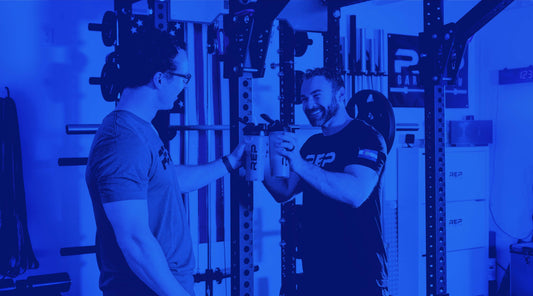
NEWSLETTER SIGNUP
Product launch information, promotions, blogs, and REP news.

